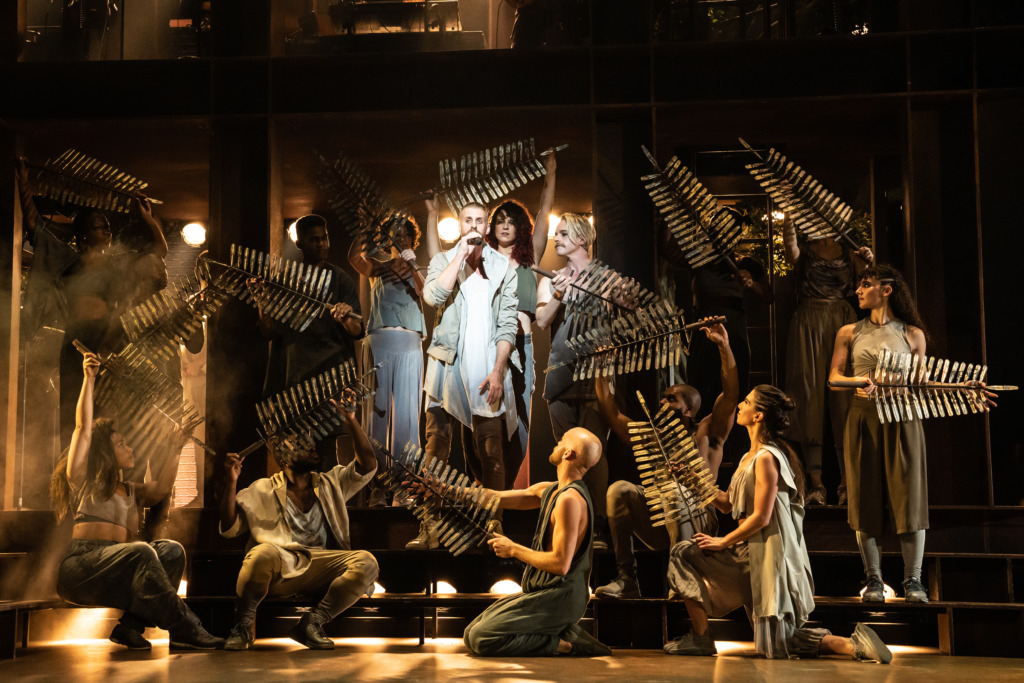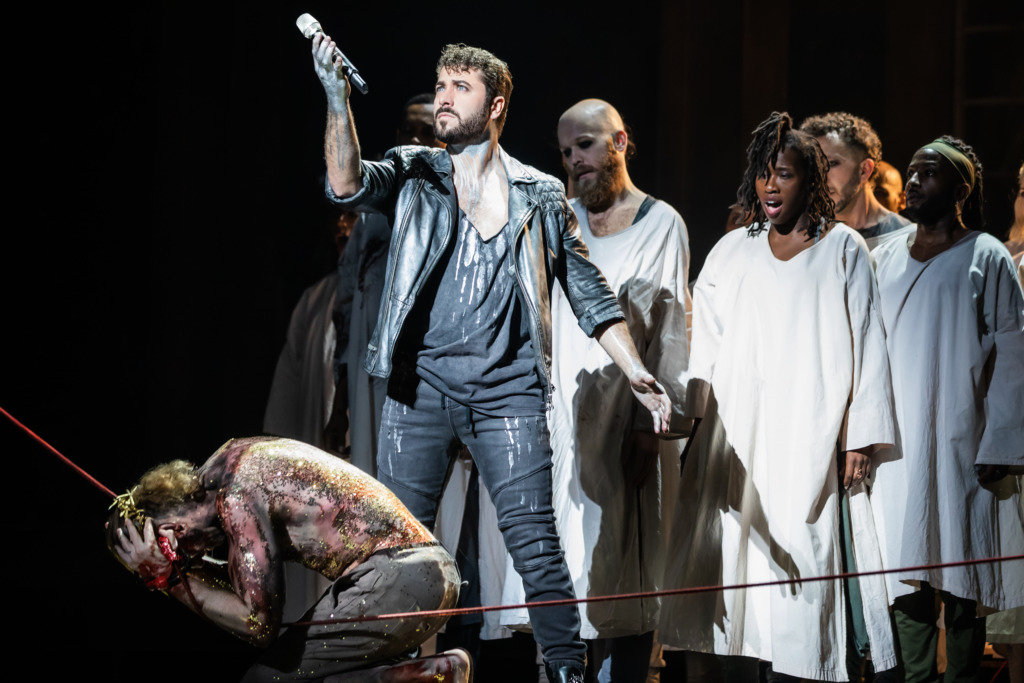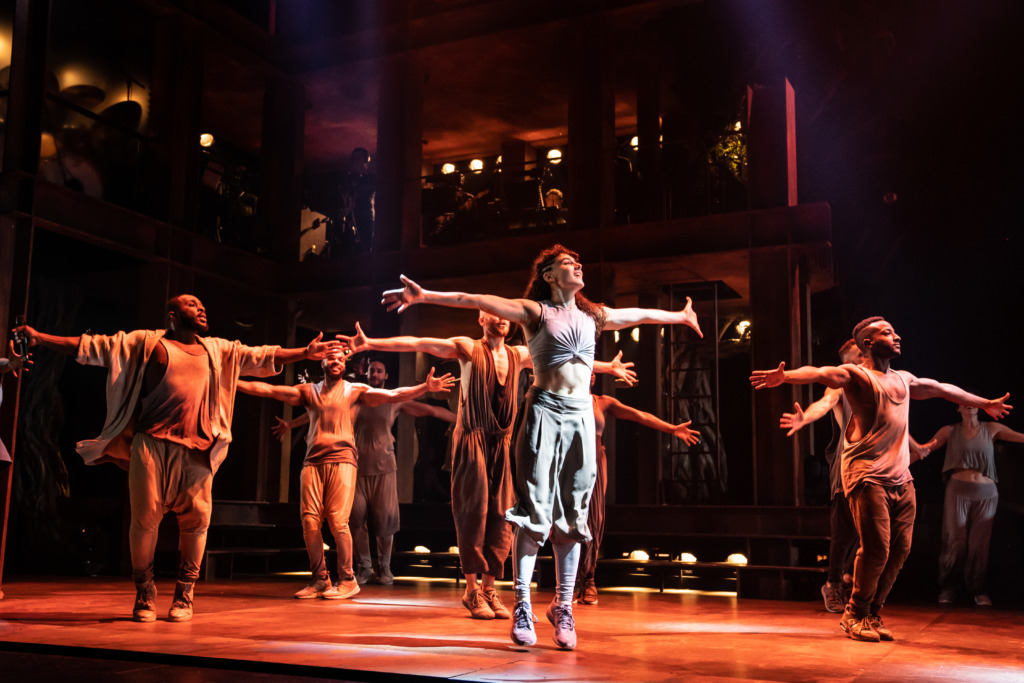Fresh off a hit run in London, the 50th Anniversary production of Andrew Lloyd Webber and Tim Rice’s groundbreaking musical Jesus Christ Superstar is electrifying audiences at the Kennedy Center through March 13th.
Featuring the well-known hits “Superstar” and “I Don’t Know How to Love Him,” Jesus Christ Superstar is a rock opera retelling of how Jesus Christ spent the last week of his life as seen through the eyes of Judas, the betrayer. Lacing together biblical drama with a propulsive rock and funk score, Director Timothy Sheader has streamlined the production for the modern age, paring back the more overblown aspects of the original for a truly rocking, slick concert and spectacle.

Originally starting life in 1970 as a concept album (which was banned by the BBC for being sacrilegious), the show debuted on Broadway in 1971 and then in London in 1972. Despite its share of enthusiastic audiences, the musical was widely criticized by Jews and Christians. Webber himself remarked: “…(It) was really not an irreligious piece, as has been so often suggested. In its own way and in its own time, it was simply a work attempting to ask a couple of questions, the chief of which was ‘Did Judas Iscariot have God on his side?”
The themes that appear throughout Superstar are those of fame, revolution, radicalism, and humility. Loosely based on the Gospels, the opera focuses on the personal conflicts between Jesus, his disciples, the people of Israel, and the leadership of Rome. Special attention is also paid to the fractured friendship between Judas Iscariot (Omar Lopez-Cepero) and Jesus (Aaron LaVigne) as well as Jesus’s relationship with Mary Magdalene (Jenna Rubaii), a devoted follower.
Director Timothy Sheader keeps the current production moving forward at a heart-pumping pulse right to the emotional climax of the title song and the Crucifixion. Both The Last Supper and the 39 Lashes drew gasps from the audience at two dramatic tableaux moments. Yet at times, the pulsing pace kept tender moments from fully landing, with even Mary’s scenes (featuring perhaps the show’s best-known songs) seeming slightly rushed, if still effective.

Conceptually, Sheader has also emphasized the performative aspects of the entire story with a decided focus on the use of hand-held microphones which can double as props. Characters play around with microphone stands like glitzy Vegas headliners; some costumes are covered in sequins; and two of the most disturbing moments in the show get a symbolic tweaking involving glitter and the image of a loose, hanging body mic. One character even attempts a mic drop.
The performances are skilled and generally rise to the operatic challenges of the roles. The conceptualization of Jesus here seems to be that of an inspired artist/musician with a message deemed radical and threatening, with tensions arising from the way that his friends (and enemies) seem to want more from him or expect him to be something other than he really is. Judas acts as the narrator of the piece, critiquing and challenging his friend’s motives.
As Judas, Omar Lopez-Cepero exudes the requisite nervous and potentially explosive energy as he watches over his friend, his steely voice cutting through some insanely high octaves with ease. Aaron LaVigne, as Jesus, is at his best communicating his inner struggles with a quiet, knowing dignity, his exhaustion and despair coming through intensely in the show-stopping mid-point number “Gesthemane (I Only Want to Say).” His suffering through the ensuing events certainly packs the appropriate punch.
Jenna Rubaii’s Mary Magdalene connects vocally and emotionally with the ever-appealing ballads “I Don’t Know How to Love Him”, “Everything’s Alright” and “Could We Start Again, Please?” which all showcase the very real human emotions of care and selfless love. Though we felt her scenes could have been allowed to linger a bit longer in the overall pacing, Rubaii creates the sense of an authentic person who reaches out to comfort Jesus in his perceived moments of weakness and vulnerability.

As for Jesus’s antagonists, Alvin Crawford’s suspicious high priest Caiaphas has a big presence and an even bigger, booming voice, while Tyce Green makes an eerie and eye-catching impression as the second priest Annas. Paul Louis Lessard’s King Herod expertly provides a few moments of comic relief in his song, especially while still maintaining the audience’s awareness that something awful is about to occur. As Pontius Pilate, Tommy Sherlock is vocally and viscerally effective, simultaneously conveying his character’s humor, power, and inner turmoil in confronting the crowd to decide if Jesus is to be crucified. The ensemble work remains fluid and compelling, with special applause for the staging of the title song and ‘The Temple’.
Drew McOnie’s choreography is an essential part of this production, whether it’s capturing the den of thieves with superficial flash or the animalistic frenzy of citizens demanding Jesus’s crucifixion. With the addition of a dancer labeled as “Mob Leader” in the program (Sarah Parker), McOnie tries to show us the chaos of the mob mentality in an on-going solo dance. Overall, the dance in this production is crisp and flawlessly executed, but it can be distracting at times.
Tom Scutt’s designs work beautifully. The band plays on a second level, but characters occasionally peer down at the action below. Slightly angled just off-center stage is a runway in the shape of a crucifix (and yes, those who know the show are aware of how this runway will be used at the end). This runway also becomes the scene for The Last Supper.
The costumes sport clever period details but still feel contemporary. And in one scene that might confuse, Scutt has the ensemble wear Roman masks to clarify ensemble roles. Lee Curran’s Rock Concert Lighting Design heightens so many poignant moments especially in The Garden of Gethsemane and in Judas’s Death. Without spoiling details for future audiences, the lighting effect at the top of the show and at the closing between Jesus and Judas becomes mesmerizingly haunting.
Musically and visually, this 50th anniversary production packs an emotional wallop. Our primary quibble with this production was momentary unbalance of orchestra and singers in some of the songs. Even though I knew many of the lyrics, those who might be seeing Jesus Christ Superstar for the first time might not fully discern all of the lyrics.
Jesus Christ Superstar plays through March 13, 2022 in the Opera House Theatre at The John F. Kennedy Center for the Performing Arts, 2700 F Street NW, Washington, DC. For tickets call the box office at (202) 467-4600 or purchase them online.
